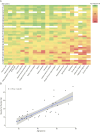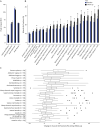Quantitative Muscle MRI to Monitor Disease Progression in Hypokalemic Period Paralysis
- PMID: 39633713
- PMCID: PMC11616970
- DOI: 10.1212/NXG.0000000000200211
Quantitative Muscle MRI to Monitor Disease Progression in Hypokalemic Period Paralysis
Erratum in
-
Erratum: Quantitative Muscle MRI to Monitor Disease Progression in Hypokalemic Periodic Paralysis.Neurol Genet. 2025 Mar 17;11(2):e200255. doi: 10.1212/NXG.0000000000200255. eCollection 2025 Apr. Neurol Genet. 2025. PMID: 40104688 Free PMC article.
Abstract
Background and objectives: Primary hypokalemic periodic paralysis (HypoPP) is a muscle channelopathy that can cause periodic paralysis and permanent weakness. Currently, little is known about how progressive this myopathy is. Natural history data for HypoPP can potentially answer the question of progressiveness and form the basis for outcome measures to be used in follow-up and emerging treatment trials. We aimed to describe the natural history of HypoPP and assess whether quantitative fat imaging is a valuable biomarker to monitor disease progression.
Methods: In this prospective follow-up study, we examined disease progression using Dixon MRI to monitor changes in fat replacement of the muscle and stationary dynamometry to monitor changes in muscle strength.
Results: We included 37 persons (mean age 43 years, range 18-79 years) with HypoPP-causing variants in CACNA1S. Three participants were asymptomatic carriers, 22 had periodic paralysis, 3 had permanent weakness, and 9 had periodic paralysis in combination with permanent weakness. The median follow-up time was 20 months (range 12-25). We found that fat fraction increased in 10 of 21 examined muscles. An increase in the composite fat fraction of at least 1 muscle group was found in all symptomatic phenotypes. By contrast, we found no significant change in muscle strength.
Discussion: The results from this follow-up study support the use of quantitative muscle MRI to monitor subclinical disease progression in HypoPP in patients with and without attacks of paralysis.
Copyright © 2024 The Author(s). Published by Wolters Kluwer Health, Inc. on behalf of the American Academy of Neurology.
Conflict of interest statement
The authors report no relevant disclosures. Go to Neurology.org/NG for full disclosures.
Figures



References
LinkOut - more resources
Full Text Sources
